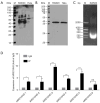CREB3-mediated upregulation of MIR210HG transcription enhances proliferation in colon cancer cells
- PMID: 40530130
- PMCID: PMC12170202
- DOI: 10.21037/tcr-24-1525
CREB3-mediated upregulation of MIR210HG transcription enhances proliferation in colon cancer cells
Abstract
Background: Understanding the regulatory mechanisms behind colon cancer (CC) pathogenesis is crucial for developing effective therapeutic strategies. Long non-coding RNA (lncRNA) MIR210HG has been implicated in various cancers, including CC, where it may play a role in tumor progression. Additionally, the transcription factor cyclic adenosine monophosphate-responsive element-binding protein 3 (CREB3) has been suggested to regulate lncRNA expression, but its role in CC remains unclear. This study investigates the CREB3-MIR210HG regulatory axis, focusing on how this interaction influences CC cell proliferation and its potential as a therapeutic target for cancer treatment.
Methods: To explore the CREB3-MIR210HG axis, bioinformatics analysis was conducted to identify the MIR210HG promoter and predict potential transcription factor binding sites. Expression levels of CREB3 and MIR210HG were analyzed using The Cancer Genome Atlas (TCGA) database, which provided a broader understanding of their correlation in human CC samples. Additionally, reverse transcription-quantitative polymerase chain reaction (RT-qPCR) was performed in SW480 CC cells to validate these findings at the cellular level. Luciferase reporter assays and chromatin immunoprecipitation (ChIP) experiments were employed to confirm the binding of CREB3 to the MIR210HG promoter, providing direct evidence of their interaction. Finally, functional assays, including cell proliferation assays and knockdown experiments, were carried out to assess the impact of MIR210HG on CREB3-induced proliferation in CC cells.
Results: Bioinformatics and experimental analysis revealed that CREB3 directly binds to the MIR210HG promoter, leading to significant upregulation of MIR210HG transcription in CC cells. Data from TCGA and RT-qPCR analyses showed a positive correlation between CREB3 and MIR210HG expression in CC tissues, supporting the hypothesis of a regulatory link. Functional assays demonstrated that overexpression of CREB3 enhanced CC cell proliferation, while silencing MIR210HG reversed this effect, indicating that MIR210HG mediates CREB3-induced proliferation. These results suggest that the CREB3-MIR210HG axis plays a critical role in CC progression.
Conclusions: This study highlights the CREB3-MIR210HG axis as a pivotal mechanism driving CC cell proliferation. Targeting this regulatory pathway may provide a novel therapeutic strategy for CC treatment, with the potential for developing lncRNA-based therapies aimed at inhibiting this axis to slow down tumor growth and progression.
Keywords: MIR210HG; Transcription regulation; colon cancer (CC); cyclic adenosine monophosphate-responsive element-binding protein 3 (CREB3); long non-coding RNA (lncRNA).
Copyright © 2025 AME Publishing Company. All rights reserved.
Conflict of interest statement
Conflicts of Interest: All authors have completed the ICMJE uniform disclosure form (available at https://tcr.amegroups.com/article/view/10.21037/tcr-24-1525/coif). The authors have no conflicts of interest to declare.
Figures




References
LinkOut - more resources
Full Text Sources
